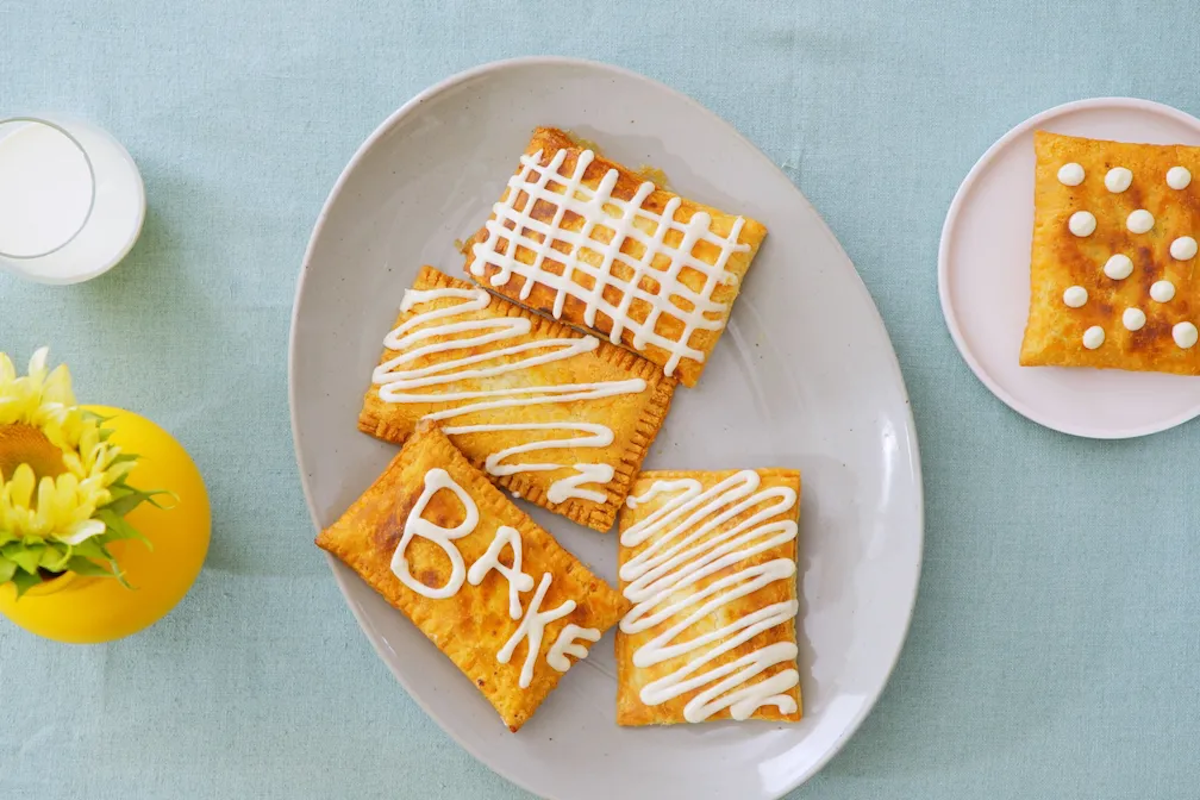A DIY toaster strudel that combines tangy cream cheese with the caramel-y flavors of brown sugar

The elusive toaster strudel is a deep-rooted memory from my ’90s childhood. Warm, flaky, and served with a packet of icing that taught me my first piping skills — I’ll remember it forever. This year, I finally tackled making my own version — and I’ll never go back! This version is super simple: cream cheese + brown sugar. Customize it to fit your favorite flavors by adding spices, citrus zest, or a dollop of jam, if you’d like. If you want to imitate the packaged stuff, skip the optional folds I recommend in step 4 — but if you’re as big a fan of flakes as I am, the end result is delightfully worth it. — Erin Jeanne McDowell
Watch this recipe
Brown Sugar & Cream Cheese “Toaster Strudel”
Yields
6 pastries
Cook Time
40 minutes
Ingredients
Dough
- 3 cups (360 grams) all-purpose flour
- 1 teaspoon (4 grams) fine sea salt
- 12 tablespoons (170 grams) cold unsalted butter, cut into ½-inch cubes
- 1 large (56 grams) egg, cold
- 1 large (21 grams) egg yolk, cold
- ¼ cups (60 grams) ice water, plus more as needed
Filling, Frying, and Finishing
- 1 large (35 grams) egg white
- 1 tablespoon (15 grams) water
- 8 ounces (226 grams) cream cheese, at room temperature
- 6 tablespoons (80 grams) light or dark brown sugar, packed
- neutral oil (such as vegetable or canola), for panfrying
- 1 cup (113 grams) confectioners’ sugar
- 3 tablespoons (45 grams) heavy cream, plus more as needed
- ½ teaspoons vanilla bean paste (or 1 teaspoon vanilla extract)
Directions
- Make the dough: In the bowl of a food processor, pulse the flour and salt to combine. Break up the butter into the food processor and pulse until the butter is very finely incorporated, looking like tiny flecks or pearls amid the flour.
- Add the egg, egg yolk, and water and pulse until the mixture comes together into a fairly smooth dough. If needed, add more water 1 teaspoon (5 grams) at a time until the dough comes together.
- Divide the dough into two even pieces (about 330 grams each). Form each into a rectangle 1 inch thick, wrap tightly in plastic wrap, and refrigerate for at least 1 hour (or up to 48 hours). After chilling, you can move immediately to step 5. For flakier dough, proceed with step 4.
- (Optional step for extra flakiness!) Working with one piece of dough at a time on a lightly floured surface, roll out the dough to ½ inch thick. Fold the dough into quarters, then immediately roll out again to ½ inch thick. Fold again into quarters. If desired, you can repeat this process a second time for even more flakiness. Then rewrap the dough and refrigerate for at least 2 hours (or up to 24 hours). Repeat with the second piece of dough.
- To roll out the dough, work with one piece of dough at a time. Roll out the dough into a rectangle ⅛ inch thick (it should be about 12×14 inches). Trim the rectangle of dough to 10½x12 inches.
- Use a paring knife to gently score the dough in half (do not cut through the dough, just leave a light indentation), dividing it into two 6-inch-wide segments. Then, use the paring knife again to gently mark the dough into three even portions on the lower 6 inches of the dough (each should be about 3½ inches wide).
- Lightly whisk the egg white with 1 tablespoon of water to combine. Spoon about 2 heaping tablespoons of cream cheese into the center of each pastry and spread into an even layer, leaving the outer ½ inch of the dough uncovered all the way around. Sprinkle 1 packed tablespoon (15 grams) brown sugar over the cream cheese for each pastry.
- Brush the egg white mixture evenly around the uncovered outer edges of the pastry. Then gently fold the excess pastry dough in half over the filling. Lay it down slowly, ideally not allowing any air pockets to form. Firmly press the dough together around the edges of the filling with your fingers to seal well.
- Use a pastry wheel to cut the pastries into three even pieces and transfer to a parchment-lined baking sheet. Crimp with the tines of a fork all the way around.
- Freeze until firm, at least 1 hour (to freeze longer, transfer once firm to an airtight container or freezer bag; freeze for up to 1 month). Heat the oven to 375°F and line a baking sheet with parchment paper.
- Panfry the pastries: In a large skillet, heat ½ inch of neutral oil over medium heat until the corner of a frozen pastry sizzles when you add it to the oil. Fry the pastries two or three at a time (don’t overcrowd the pan) until the surface is evenly golden brown, 3 to 5 minutes. Adjust the heat as needed to brown the pastries slowly and evenly.
- Turn the pastry over and cook on the other side until golden brown. Use a large spatula (I like a flexible fish spatula) to gently transfer the fried pastries to the prepared baking sheet. Continue to fry the remaining pastries, placing them evenly on the baking sheet once they are browned.
- Transfer the baking sheet to the oven and bake until the pastry is fully baked through, 15 to 18 minutes. Cool at least 10 minutes on the baking sheet before serving warm.
- While the pastries cool, make the icing: In a medium bowl, whisk the confectioners’ sugar, cream, and vanilla to make a thick icing. Add more cream as needed to make the icing easily pipable or spreadable.
- When ready to serve, pipe or spread icing onto the surface of the pastry. Serve immediately.


